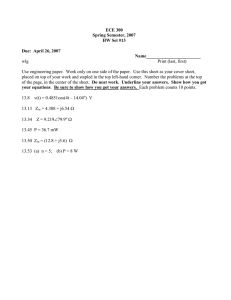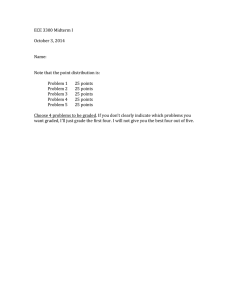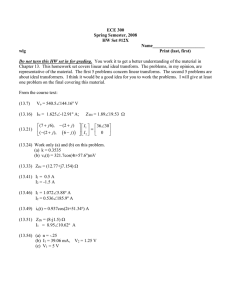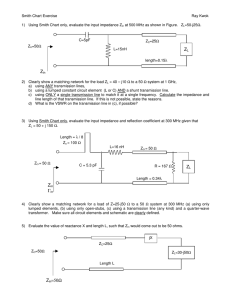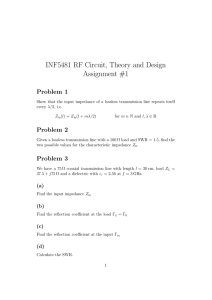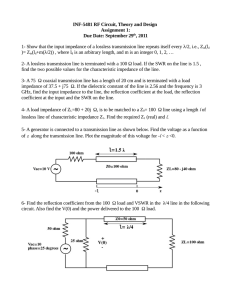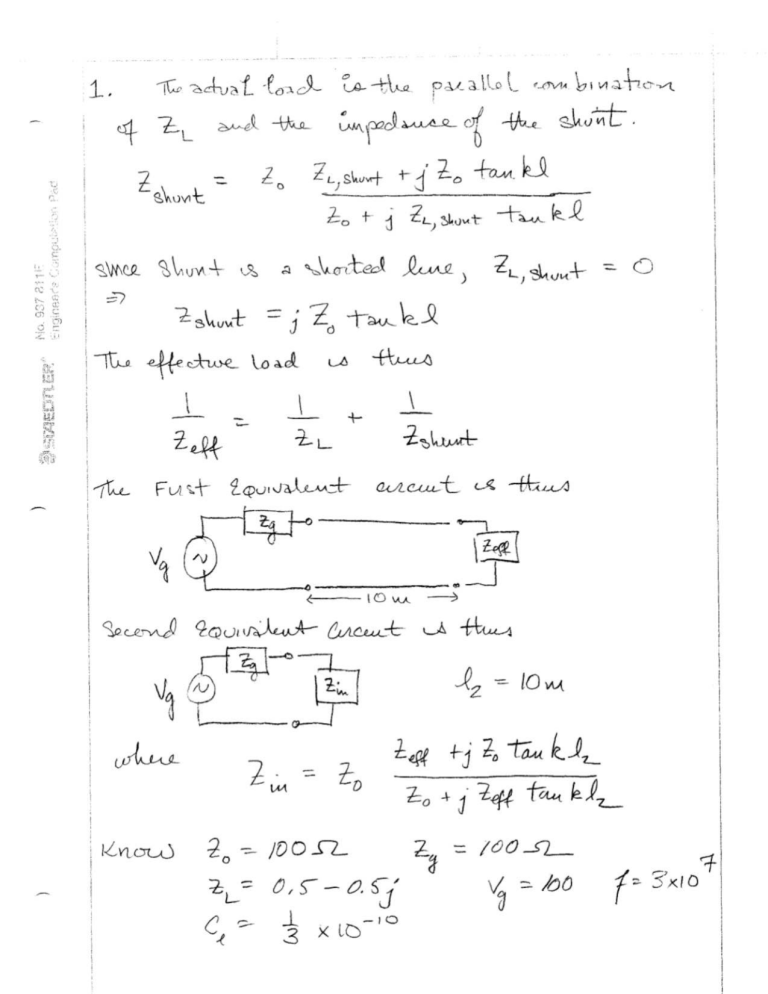
Problem 2.27 At an operating frequency of 300 MHz, a lossless 50-Ω air-spaced transmission line 2.5 m in length is terminated with an impedance ZL = (40+ j20) Ω. Find the input impedance. Solution: Given a lossless transmission line, Z0 = 50 Ω, f = 300 MHz, l = 2 5 m, and ZL = (40 + j20) Ω. Since the line is air filled, up = c and therefore, from Eq. (2.48), ω 2π × 300 × 106 = = 2π rad/m β= up 3 × 108 Since the line is lossless, Eq. (2.79) is valid: µ ¶ · ¸ ZL + jZ0 tan β l (40 + j20) + j50 tan (2π rad/m × 2 m) Zin = Z0 = 50 Z0 + jZL tan β l 50 + j(40 + j20) tan (2π rad/m × 2 5 m) = 50 [(40 + j20) + j50 × 0] 50 + j(40 + j20) × 0 = (40 + j20) Ω Problem 2.32 A 6-m section of 150-Ω lossless line is driven by a source with vg (t) = 5 cos(8π × 107t − 30◦ ) (V) and Zg = 150 Ω. If the line, which has a relative permittivity εr = 2 5, is terminated in a load ZL = (150 − j50) Ω, determine: (a) λ on the line. (b) The reflection coefficient at the load. (c) The input impedance. (d) The input voltage Vei . (e) The time-domain input voltage vi (t). (f) Quantities in (a) to (d) using CD Modules 2.4 or 2.5. Solution: vg (t) = 5 cos(8π × 107 t − 30◦ ) V ◦ Veg = 5e− j30 V 150 Ω I~ i Zg ~ Vg + ~ Vi Transmission line + + Z0 = 150 Ω Zin ~ VL ~ IL ZL (150-j50) Ω Generator Load l=6m z = -l z=0 ⇓ Zg ~ Vg + ~ Ii + ~ Vi Zin Figure P2.32: Circuit for Problem 2.32. (a) 3 × 108 c = √ = 2 × 108 (m/s) εr 2 5 up 2π up 2π × 2 × 108 = 5 m λ= = = f ω 8π × 107 ω 8π × 107 β= = = 0 π (rad/m) up 2 × 108 up = √ βl = 0 π × 6 = 2 π (rad) Since this exceeds 2π (rad), we can subtract 2π , which leaves a remainder β l = 0 π (rad). ZL − Z0 150 − j50 − 150 − j50 ◦ (b) Γ = = = = 0 6 e− j80 54 . ZL + Z0 150 − j50 + 150 300 − j50 (c) · ¸ ZL + jZ0 tan β l Zin = Z0 Z0 + jZL tan β l · ¸ (150 − j50) + j150 tan(0 π ) = 150 = (115 70 + j27 2) Ω 150 + j(150 − j50) tan(0 π ) (d) Vei = ◦ Veg Zin 5e− j30 (115 + j27 2) = Zg + Zin 150 + 115 7 + j27 2 µ ¶ 115 + j27 2 − j30◦ = 5e 265 + j27 2 ◦ = 5e− j30 × 0 4 e j7 4◦ = 2 e− j22 56 ◦ (V) (e) ◦ vi (t) = R e[Vei e jω t ] = R e[2 e− j22 56 e jω t ] = 2 cos(8π × 107 t − 22 56◦ ) V eg = 300 V and Zg = 50 Ω is connected to a load Problem 2.42 A generator with V ZL = 75 Ω through a 50-Ω lossless line of length l = 0 5λ . (a) Compute Zin , the input impedance of the line at the generator end. (b) Compute Iei and Vei . (c) Compute the time-average power delivered to the line, Pin = 12 R e[Vei Iei∗]. eL , IeL , and the time-average power delivered to the load, (d) Compute V 1 eL Ie∗]. How does Pin compare to PL ? Explain. PL = 2 R e[V L (e) Compute the time-average power delivered by the generator, Pg , and the timeaverage power dissipated in Zg . Is conservation of power satisfied? Solution: 50 Ω ~ Vg Transmission line + 75 Ω Z0 = 50 Ω Zin - l = 0.15 λ Generator z = -l Load z=0 ⇓ Zg ~ Vg + ~ Ii + ~ Vi Zin Figure P2.42: Circuit for Problem 2.42. (a) βl = 2π × 0 5λ = 54◦ λ · Zin = Z0 ¸ · ¸ 75 + j50 tan 54◦ ZL + jZ0 tan β l = 50 = (41 5 − j16 5) Ω Z0 + jZL tan β l 50 + j75 tan 54◦ (b) eg V 300 ◦ = = 3 4 e j10 6 (A) Zg + Zin 50 + (41 5 − j16 5) ◦ ◦ Vei = Iei Zin = 3 4 e j10 6 (41 5 − j16 35) = 143 6 e− j11 6 (V) Iei = (c) Pin = 1 ◦ ◦ 1 R e[Vei Iei∗] = R e[143 6 e− j11 6 × 3 4 e− j10 6 ] 2 2 143 6 × 3 4 = cos(21 2◦ ) = 216 (W) 2 (d) ZL − Z0 75 − 50 = = 0 ZL + Z0 75 + 50 µ ¶ ◦ 1 143 e− j11 6 − j54◦ ei V0+ = V = ◦ ◦ = 150e j54 − j54 j β l j β l − e +0 e e + Γe ◦ ◦ + − j54 eL = V (1 + Γ) = 150e V (1 + 0 ) = 180e− j54 (V) Γ= 0 V0+ (V) ◦ ◦ 150e− j54 (1 − 0 ) = 2 e− j54 (A) Z0 50 1 1 ◦ ◦ PL = R e[VeL IeL∗] = R e[180e− j54 × 2 e j54 ] = 216 (W) 2 2 IeL = (1 − Γ) = PL = Pin , which is as expected because the line is lossless; power input to the line ends up in the load. (e) Power delivered by generator: Pg = 1 1 R e[Veg Iei ] = R e[300 × 3 4 e j10 2 2 6◦ ] = 486 cos(10 6◦ ) = 478 (W) 1 1 1 1 R e[IeiVeZg ] = R e[Iei Iei∗Zg ] = |Iei |2 Zg = (3 4) 2 × 50 = 262 2 2 2 2 (W) Power dissipated in Zg : PZg = Note 1: Pg = PZg + Pin = 478 W. Problem 2.45 The circuit shown in Fig. P2.45 consists of a 100-Ω lossless transmission line terminated in a load with ZL = (50 + j100) Ω. If the peak value of eL | = 12 V, determine: the load voltage was measured to be |V (a) the time-average power dissipated in the load, (b) the time-average power incident on the line, (c) the time-average power reflected by the load. Rg ~ Vg + Z0 = 100 ZL = (50 + j100) Figure P2.45: Circuit for Problem 2.45. Solution: (a) Γ= ZL − Z0 50 + j100 − 100 − 50 + j100 = = = 0 2e j82 ZL + Z0 50 + j100 + 100 150 + j100 The time average power dissipated in the load is: 1 e 2 |IL | RL 2 ¯ ¯2 ¯ 1¯ ¯VeL ¯ = ¯ ¯ RL 2 ¯ZL ¯ Pav = = 1 50 1 |VeL |2 RL = × 122 × 2 = 0 9W 2 2 |ZL | 2 50 + 1002 (b) i Pav = Pav (1 − |Γ|2 ) Hence, i Pav = Pav 0 9 = = 0 7W 2 1 − |Γ| 1 − 0 622 (c) r i Pav = − |Γ|2 Pav = − (0 2) 2 × 0 7 = − 0 8 W Problem 2.66 A 200-Ω transmission line is to be matched to a computer terminal with ZL = (50 − j25) Ω by inserting an appropriate reactance in parallel with the line. If f = 800 MHz and εr = 4, determine the location nearest to the load at which inserting: (a) A capacitor can achieve the required matching, and the value of the capacitor. (b) An inductor can achieve the required matching, and the value of the inductor. Solution: (a) After entering the specified values for ZL and Z0 into Module 2.6, we have zL represented by the red dot in Fig. P2.66(a), and yL represented by the blue dot. By moving the cursor a distance d = 0 93λ , the blue dot arrives at the intersection point between the SWR circle and the S = 1 circle. At that point y(d) = 1 26126 − j1 402026 To cancel the imaginary part, we need to add a reactive element whose admittance is positive, such as a capacitor. That is: ω C = (1 4206) × Y0 1 4206 1 4206 = = = 7 1 × 10− 3 Z0 200 which leads to C= 7 1 × 10− 3 = 1 3 × 10− 12 F 2π × 8 × 108 Figur e P2.66(a) (b) Repeating the procedure for the second intersection point [Fig. P2.66(b)] leads to y(d) = 1 000001 + j1 520691 at d2 = 0 47806λ . To cancel the imaginary part, we add an inductor in parallel such that 1 1 20691 = ωL 200 from which we obtain L= 200 = 2 618 × 10− 8 H 1 52 × 2π × 8 × 108 Figure P2.66(b) Problem 2.31 A voltage generator with vg (t) = 5 cos(2π × 109 t) V and internal impedance Zg = 50 Ω is connected to a 50-Ω lossless air-spaced transmission line. The line length is 5 cm and the line is terminated in a load with impedance ZL = (100 − j100) Ω. Determine: (a) Γ at the load. (b) Zin at the input to the transmission line. (c) The input voltage Vei and input current I˜i . (d) The quantities in (a)–(c) using CD Modules 2.4 or 2.5. Solution: (a) From Eq. (2.59), Γ= ZL − Z0 (100 − j100) − 50 = = 0 2e− j29 ZL + Z0 (100 − j100) + 50 ◦ (b) All formulae for Zin require knowledge of β = ω p . Since the line is an air line, up = c, and from the expression for vg (t) we conclude ω = 2π × 109 rad/s. Therefore 2π × 109 rad/s 20π β= = rad/m 3 × 108 m/s 3 Then, using Eq. (2.79), µ ¶ ZL + jZ0 tan β l Zin = Z0 Z0 + jZL tan β l " ¡ ¢# (100 − j100) + j50 tan 203π rad/m × 5 cm ¢ ¡ = 50 50 + j(100 − j100) tan 203π rad/m × 5 cm " ¢# ¡ (100 − j100) + j50 tan π3 rad ¡ ¢ = (12 − j12 ) Ω = 50 50 + j(100 − j100) tan π3 rad ◦ eg = 5 Ve j0 . From Eq. (2.80), (c) In phasor domain, V Vei = Veg Zin 5 × (12 5 − j12 7) = = 1 0e− j34 Zg + Zin 50 + (12 − j12 ) ◦ and also from Eq. (2.80), ◦ ◦ Vei 1 e− j34 Iei = = = 78 e j11 5 Zin (12 5 − j12 7) (mA) (V) Problem 2.33 Two half-wave dipole antennas, each with an impedance of 75 Ω are connected in parallel through a pair of transmission lines, and the combination is connected to a feed transmission line, as shown in Fig. P2.33. 0.2 0.3 75 Ω (Antenna) Zin1 Zin2 Zin 0.2 75 Ω (Antenna) Figure P2.33: Circuit for Problem 2.33. All lines are 50 Ω and lossless. (a) Calculate Zin1 , the input impedance of the antenna-terminated line, at the parallel juncture. (b) Combine Zin1 and Zin2 in parallel to obtain ZL′ , the effective load impedance of the feedline. (c) Calculate Zin of the feedline. Solution: (a) · Zin1 ¸ ZL1 + jZ0 tan β l1 = Z0 Z0 + jZL1 tan β l1 ½ ¾ 75 + j50 tan[(2π λ )(0 λ )] = 50 = (35 0 − j8 62) Ω 50 + j75 tan[(2π λ )(0 λ )] (b) ZL′ = (c) Zin1 Zin2 (35 0 − j8 62) 2 = = (17 0 − j4 1) Ω Zin1 + Zin2 2(35 0 − j8 2) l = 0.3 λ ZL' Zin Figure P2.33: (b) Equivalent circuit. ½ (17 60 − j4 31) + j50 tan[(2π λ )(0 3λ )] Zin = 50 50 + j(17 60 − j4 31) tan[(2π λ )(0 3λ )] ¾ = (107 57 − j56 7) Ω Problem 2.39 A 75-Ω resistive load is preceded by a λ section of a 50-Ω lossless line, which itself is preceded by another λ section of a 100-Ω line. What is the input impedance? Compare your result with that obtained through two successive applications of CD Module 2.5. Solution: The input impedance of the λ section of line closest to the load is found from Eq. (2.97): Z 2 502 = 33 3 Ω Zin = 0 = ZL 75 The input impedance of the line section closest to the load can be considered as the load impedance of the next section of the line. By reapplying Eq. (2.97), the next section of λ line is taken into account: Zin = Z02 1002 = = 300 Ω ZL 33 3 Problem 2.43 If the two-antenna configuration shown in Fig. P2.43 is connected to eg = 250 V and Zg = 50 Ω, how much average power is delivered to a generator with V each antenna? λ/2 50 Ω λ/2 A + Zin 250 V − C L in e2 ZL 1 = 75 Ω (Antenna 1) L ine 1 B D Gener ator L in e3 λ/2 ZL 2 = 75 Ω (Antenna 2) Figure P2.43: Antenna configuration for Problem 2.43. Solution: Since line 2 is λ in length, the input impedance is the same as ZL1 = 75 Ω. The same is true for line 3. At junction C–D, we now have two 75-Ω impedances in parallel, whose combination is 75 = 37 5 Ω. Line 1 is λ long. Hence at A–C, input impedance of line 1 is 37.5 Ω, and Iei = Pin = eg V 250 = Zg + Zin 50 + 37 = 2 6 (A) 1 (2 86) 2 × 37 5 ∗ ei∗] = 1 R e[Iei Iei∗Zein R e[IeiV ]= = 153 7 (W) 2 2 2 This is divided equally between the two antennas. Hence, each antenna receives 153 37 = 76 8 (W). 2 Problem 2.74 A 25-Ω antenna is connected to a 75-Ω lossless transmission line. Reflections back toward the generator can be eliminated by placing a shunt impedance Z at a distance l from the load (Fig. P2.74). Determine the values of Z and l. l =? B Z0 = 75 Ω A ZL = 25 Ω Z=? Figure P2.74: Circuit for Problem 2.74. Solution: 0.250 λ 0.4 jX /Z 1.2 0.9 1.4 1.6 1.8 2.0 0.5 0.0 6 0.4 4 0. 4 (+ 5 EN T 0 .4 0.25 0.26 0.24 0.27 0.23 0.25 0.24 0.26 0.23 E 0.27 RE FLEC TIO N CO FFIC IEN T IN D EG LE OF REES AN G N PO 1.0 VE C TI 0.2 IN D U 0.8 160 RE AC ERA TO R 0.47 TA N CE CO M 4 0.0 6 150 0.4 > 0.3 RD G EN 0.22 5.0 20 0.6 0.48 4.0 1 .0 0.28 TO W A 9 0.8 1 GTH S 3.0 0.6 SWR Circle 0.2 0.1 0.49 170 10 0.4 20 0.2 50 20 10 5.0 4.0 3.0 2.0 1.8 1.6 1.4 1.2 1.0 0.9 0.8 0.7 0.6 0.5 0.4 0.3 0.2 0.1 ± 180 0.2 0.4 0.1 / Yo) (-jB E CE US ES IV CT U D IN R 0.15 0.35 0.14 -80 0.36 -90 0.13 0.37 0.12 0.38 0.11 -100 0.39 ITI V ER EA C TA N -11 0 0.1 0. 4 CE -12 0 0.0 9 0.4 1 EN T (- j 6 0.0 N 0.5 2.0 1.8 1.6 1.4 -7 0 1.2 4 0.3 C 0.9 6 0.1 1.0 7 0.8 3 AP A C 0.7 0.3 0.2 -60 0.0 7 -1 30 0.4 0.6 0.1 PO 0 .08 0.4 2 4 -1 Z X/ 2 CO M 0 o) 5 0 .0 ,O 0.3 1 4 0.4 0.4 0.1 9 0.3 < PT 1.0 C AN 0.6 3 5 0.4 0.3 -4 0 8 0.1 0 -5 4 0.0 0 -15 0.8 3 .0 6 0.4 1.0 V EL WA -1 60 0.28 0.2 9 0 .2 4 0. 0.2 1 -30 0.3 4.0 TH EN G 0 .8 0.22 0.2 -2 0 0 .47 0.6 5.0 AD < ARD LO S TO W -170 RESISTAN CE COMPONENT (R/ Zo), OR CON DUCTAN CE COMPON EN T (G/ Yo) 10 0.48 B 20 0.0 50 A 50 > W A VEL EN 8 2 0.2 0.0 0.1 0.3 50 30 0.49 0.1 7 0.3 3 60 0.2 0.3 0.500 λ 6 4 0.2 14 0 NC 0.3 40 0 .0 5 PA A PT CE US ES 0.1 70 Yo ) jB/ E (+ 1 0.3 CA R 0.15 0.35 80 9 0.1 ,O V TI CI 0.6 12 0 7 0.0 o) 0.14 0.36 90 0.7 2 0.4 3 0. 4 0 13 110 1 0.4 8 0.0 0.8 0.4 9 0.0 0.37 0.38 0.39 100 1.0 0.1 0.13 0.12 0.11 0.750 λ The normalized load impedance is: zL = 25 = 0 33 75 (point A on Smith chart) The Smith chart shows A and the SWR circle. The goal is to have an equivalent impedance of 75 Ω to the left of B. That equivalent impedance is the parallel combination of Zin at B (to the right of the shunt impedance Z) and the shunt element Z. Since we need for this to be purely real, it’s best to choose l such that Zin is purely real, thereby choosing Z to be simply a resistor. Adding two resistors in parallel generates a sum smaller in magnitude than either one of them. So we need for Zin to be larger than Z0 , not smaller. On the Smith chart, that point is B, at a distance l = λ from the load. At that point: zin = 3 which corresponds to yin = 0 33 Hence, we need y, the normalized admittance corresponding to the shunt impedance Z, to have a value that satisfies: yin + y = 1 y = 1 − yin = 1 − 0 33 = 0 66 1 1 = 1 z= = y 0 6 Z = 75 × 1 5 = 112 5 Ω In summary, λ 4 Z = 112 l= Ω
